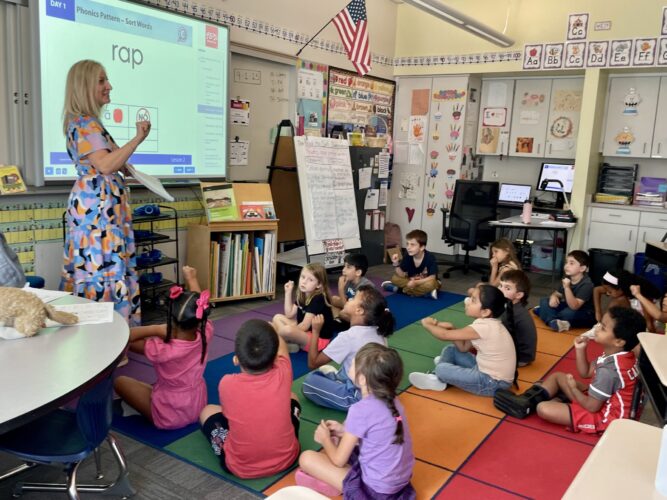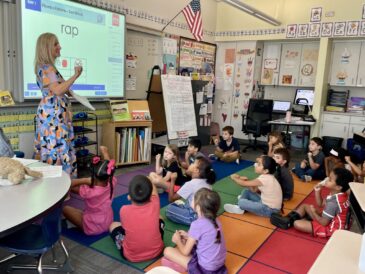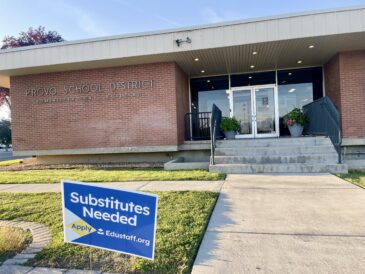Utah officials celebrate back to school with a record $111.3M from land investments

Katie McKellar, Utah News Dispatch
A teacher at Whittier Elementary School in Salt Lake City teaches English to her class after state officials held a news conference at the school on Sept. 2, 2025.State and local education officials welcomed students back to school by announcing more than $111.3 million in land investment revenue will be distributed to schools for the 2025-2026 school year — the largest ever yearly distribution in the state program’s history.
“I’m proud to share that the Permanent State School Fund has grown from about $50 million in 1994 to $3.7 billion today,” Utah State Treasurer Marlo Oaks said during a news conference Tuesday at Whittier Elementary School in Salt Lake City.
“This remarkable growth is a result of careful stewardship, prudent administration of trust lands and investment assets, and the foresight of those who established the trust system to support Utah’s education programs now and for years to come,” he said.
The record $111.3 million distribution comes after Utah voters last year approved a constitutional amendment, Amendment B, which increased the amount that can be distributed from the Permanent State School Fund, an endowment created at statehood to support public schools.
Approved by voters, Amendment B changed the Utah Constitution to increase the limit of the annual distributions from the fund to public schools from 4% to 5% of the fund. Last year, before the amendment, schools received about $106 million under the 4% distribution cap.
That 1% change, however, means “beginning in the fall of 2026, schools will have access to even more resources to support students in the classroom, while the fund itself continues to grow for future generations,” Oaks said. “Amendment B helps us to better meet the needs of children today without sacrificing the needs of future students.”
The $111.3 million in LAND Trust funds will support more than 647,000 students in 1,019 schools statewide, distributed on a per-pupil basis, according to the Utah Land Trusts Protection & Advocacy Office.
“Utah’s School LAND Trust Program is unlike anything else in the nation,” said State Superintendent of Public Instruction Molly Hart. “While other states have school trust lands, Utah has set the gold standard in managing these assets into a $3.7 billion Permanent State School Fund that directly improves education outcomes and learning in every K-12 public school throughout Utah.”
Hart said she’s personally seen how the annual distribution has grown — from $29 million when she first arrived in Utah in 2012 to $111 million for this year’s distribution.
She called that “simply remarkable.”
“What makes this program so successful and powerful is that the decisions are made locally by school community council members and land trust councils that are made up of principals and teachers and parents and grandparents who know their students best,” Hart said. “This ensures that every single dollar is strategically invested where it will make the greatest impact.”
Utah — one of the fastest growing states that’s also known for large families — struggles to keep pace with education needs. For the 2026 fiscal year, roughly 38% of the state’s $30.8 billion budget went toward public and higher education, according to the state budget.
However, the state consistently ranks among the lowest in the nation for per-pupil spending.
Salt Lake City School District Superintendent Elizabeth Grant told Utah News Dispatch the School LAND Trust program makes a “huge difference” by helping provide much-needed funding for schools.
“Utah schools are very good at making due with what they have, the funding that they get,” she said. “So we use the dollars well.”
How does Utah’s school land trust system work?
Four agencies make up Utah’s School and Institutional Trust System. The Trust Lands Administration manages about 3.3 million acres of trust lands in Utah, granted by Congress at statehood in 1896 with the requirement that revenue earned from the sale or lease of the land be placed into permanent endowment for public schools. The revenue is generated from activities like energy development, real estate and grazing.
The School LAND Trust program, housed in the State Board of Education, distributes annual investment earnings directly to local schools and empowers communities to decide how best to meet their needs through land trust councils that decide how to spend the money.
The Utah School & Institutional Trust Funds Office is made up of an independent team of investors tasked with investing the revenue in the Permanent State School Fund to grow the endowment. And the Utah Land Trusts Protection & Advocacy Office ensures the fund’s beneficiaries’ interests — primarily school children — are protected and represented.
How much are schools getting?
Alpine School District — Utah’s most populated — got the biggest distribution, more than $13 million. Davis School District got $10.6 million; Granite and Jordan school districts received more than $8.7 million each; Nebo School District got more than $6.6 million; and Washington District got $5.6 million. Those are just some of the top earners due to their large school populations.
Salt Lake City School District received more than $3 million in this year’s distribution for more than 19,000 students. Included in that disbursement, Whittier Elementary in Salt Lake City got more than $77,000.
As part of Tuesday’s celebrations, Oaks presented Whittier Elementary Principal Vanessa Jordan with an oversized check.
Whittier Elementary school community councils chose to use the $77,000 to support building literacy skills for young students.
“This year, our land trust funds will provide funding for a part-time certified teacher (and a) paraprofessional who will both support literacy intervention for kindergarten, first grade, and second grade students,” Jordan said.
Here are some more examples of how schools across the state plan to use their distributions this year, according to state officials:
- Desert Canyons Elementary in Washington County School District plans to use the funds to hire and train paraprofessionals who support reading and math instruction.
- Canyon View Middle in Emery County School District is looking to provide specialized literacy-focused teacher training, technology to identify learning gaps, and an instructional coach.
- Sky View High in Cache County School District intends to expand access to concurrent enrollment, AP classes, and ACT prep with an aim of raising graduation rates and boosting college readiness.



